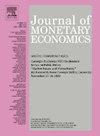Globalization, structural change and international comovement
IF 4.3
2区 经济学
Q1 BUSINESS, FINANCE
引用次数: 0
Abstract
We study the roles of globalization and structural change in the evolution of international GDP comovement over the period 1978–2007. In this period, trade integration between advanced economies increased rapidly while average GDP correlations remained stable. Structural change – reallocation of economic activity towards services – is important in resolving this apparent puzzle. Business cycle shocks in the service sector are less internationally correlated than in manufacturing, and thus structural change lowers GDP comovement by increasing the GDP share of less correlated sectors. Globalization – reductions in trade costs – exerts two opposing effects on international comovement. While greater trade linkages increase international transmission of shocks, globalization also induces structural change towards services. We quantify these effects in a multi-country, multi-sector model of international production and trade. The two opposing effects of globalization on comovement largely cancel each other out, limiting the net contribution of globalization to increasing international comovement.
全球化、结构变化和国际运动
我们研究了全球化和结构变化在 1978-2007 年期间国际国内生产总值相关性演变中的作用。在此期间,发达经济体之间的贸易一体化迅速发展,而国内生产总值的平均相关性却保持稳定。结构变化--经济活动向服务业的重新配置--对于解决这一明显的谜题非常重要。与制造业相比,服务业的商业周期冲击的国际相关性较低,因此,结构变化通过增加相关性较低部门的国内生产总值份额来降低国内生产总值的相关性。全球化--贸易成本的降低--对国际相关性产生了两种相反的影响。虽然贸易联系的加强会增加冲击的国际传播,但全球化也会促使结构向服务业转变。我们在一个多国、多部门的国际生产和贸易模型中量化了这些影响。全球化对相互影响的两种对立效应在很大程度上相互抵消,限制了全球化对增加国际相互影响的净贡献。
本文章由计算机程序翻译,如有差异,请以英文原文为准。
求助全文
约1分钟内获得全文
求助全文
来源期刊

Journal of Monetary Economics
Multiple-
CiteScore
7.20
自引率
4.90%
发文量
90
审稿时长
74 days
期刊介绍:
The profession has witnessed over the past twenty years a remarkable expansion of research activities bearing on problems in the broader field of monetary economics. The strong interest in monetary analysis has been increasingly matched in recent years by the growing attention to the working and structure of financial institutions. The role of various institutional arrangements, the consequences of specific changes in banking structure and the welfare aspects of structural policies have attracted an increasing interest in the profession. There has also been a growing attention to the operation of credit markets and to various aspects in the behavior of rates of return on assets. The Journal of Monetary Economics provides a specialized forum for the publication of this research.
 求助内容:
求助内容: 应助结果提醒方式:
应助结果提醒方式:


